Managing Deloitte's Digital Transformation: A Project Report
VerifiedAdded on 2023/06/09
|17
|3302
|234
Project
AI Summary
This project analyzes Deloitte's digital transformation, focusing on enhancing employee performance through digital technologies. It examines the project lifecycle, including initiation, planning, execution, and closure, and highlights the importance of each stage. The project includes a comprehensive project management plan (PMP) covering scope, cost, quality, time, resources, risk, and communication. It also explores research methods, including quantitative approaches and data collection techniques using questionnaires. A work breakdown structure (WBS) and Gantt chart are employed for project organization and time management. The project presents findings from a survey of Deloitte employees and concludes with recommendations for improving the digital transformation process.
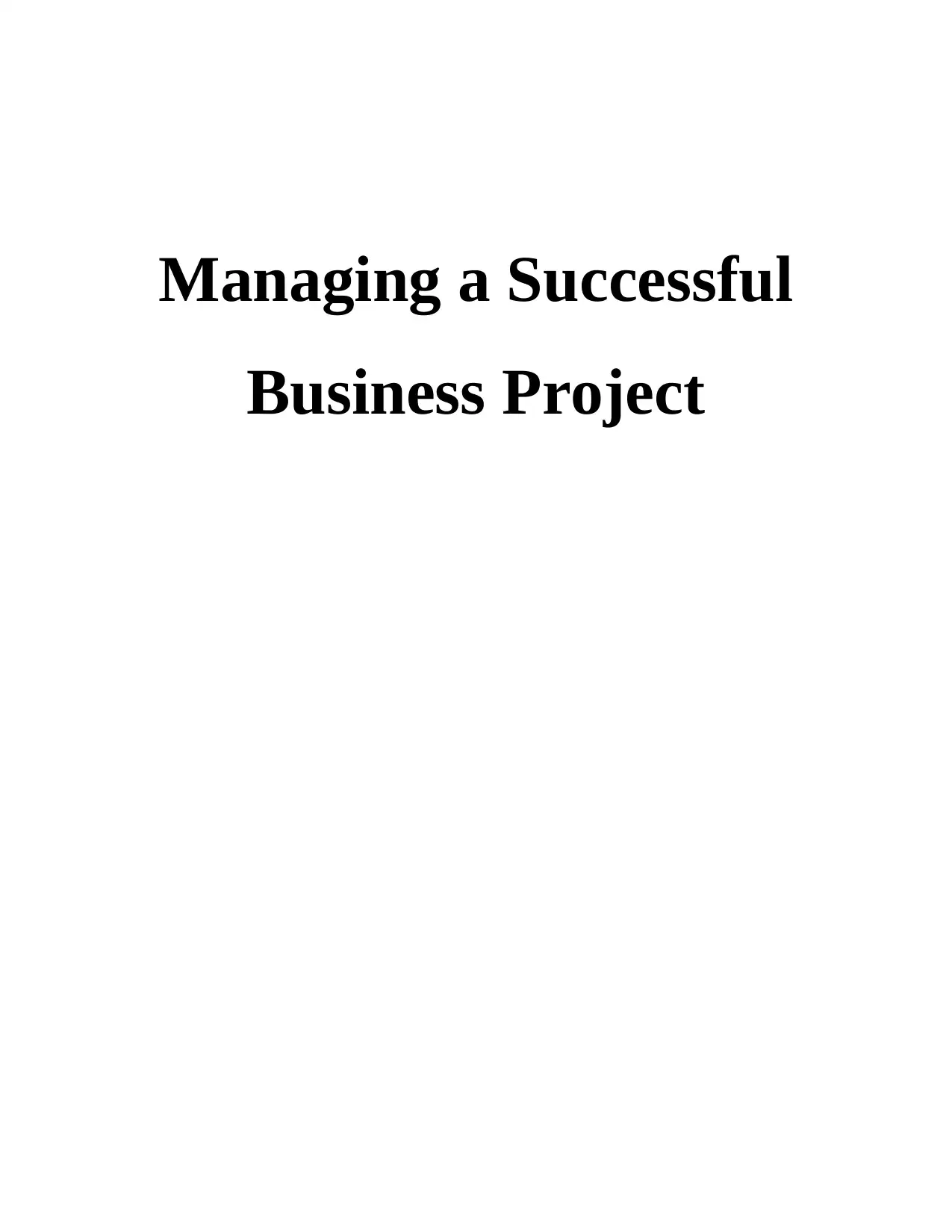
Managing a Successful
Business Project
Business Project
Paraphrase This Document
Need a fresh take? Get an instant paraphrase of this document with our AI Paraphraser

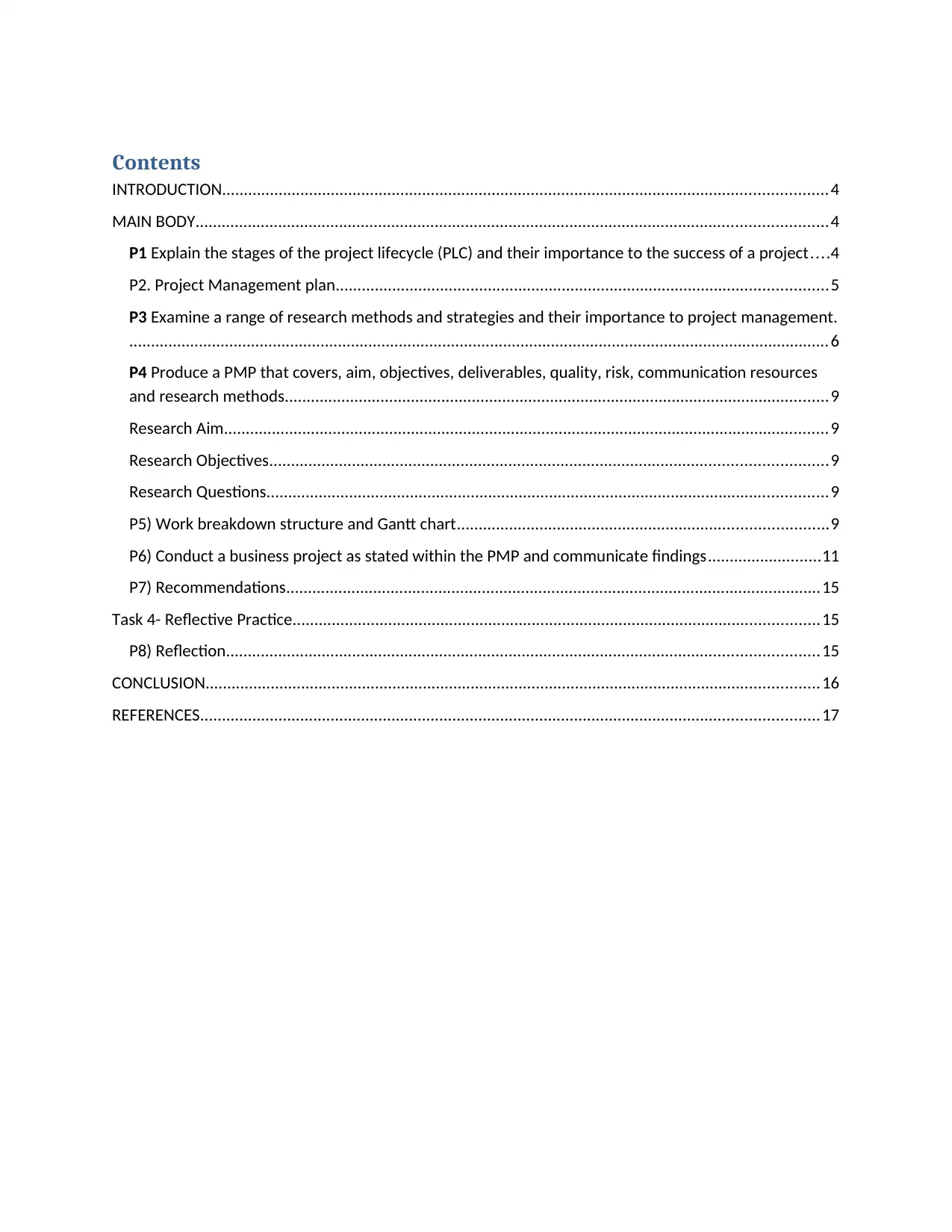
Contents
INTRODUCTION...........................................................................................................................................4
MAIN BODY.................................................................................................................................................4
P1 Explain the stages of the project lifecycle (PLC) and their importance to the success of a project....4
P2. Project Management plan.................................................................................................................5
P3 Examine a range of research methods and strategies and their importance to project management.
.................................................................................................................................................................6
P4 Produce a PMP that covers, aim, objectives, deliverables, quality, risk, communication resources
and research methods.............................................................................................................................9
Research Aim...........................................................................................................................................9
Research Objectives................................................................................................................................9
Research Questions.................................................................................................................................9
P5) Work breakdown structure and Gantt chart.....................................................................................9
P6) Conduct a business project as stated within the PMP and communicate findings..........................11
P7) Recommendations...........................................................................................................................15
Task 4- Reflective Practice.........................................................................................................................15
P8) Reflection........................................................................................................................................15
CONCLUSION.............................................................................................................................................16
REFERENCES..............................................................................................................................................17
INTRODUCTION...........................................................................................................................................4
MAIN BODY.................................................................................................................................................4
P1 Explain the stages of the project lifecycle (PLC) and their importance to the success of a project....4
P2. Project Management plan.................................................................................................................5
P3 Examine a range of research methods and strategies and their importance to project management.
.................................................................................................................................................................6
P4 Produce a PMP that covers, aim, objectives, deliverables, quality, risk, communication resources
and research methods.............................................................................................................................9
Research Aim...........................................................................................................................................9
Research Objectives................................................................................................................................9
Research Questions.................................................................................................................................9
P5) Work breakdown structure and Gantt chart.....................................................................................9
P6) Conduct a business project as stated within the PMP and communicate findings..........................11
P7) Recommendations...........................................................................................................................15
Task 4- Reflective Practice.........................................................................................................................15
P8) Reflection........................................................................................................................................15
CONCLUSION.............................................................................................................................................16
REFERENCES..............................................................................................................................................17
⊘ This is a preview!⊘
Do you want full access?
Subscribe today to unlock all pages.

Trusted by 1+ million students worldwide
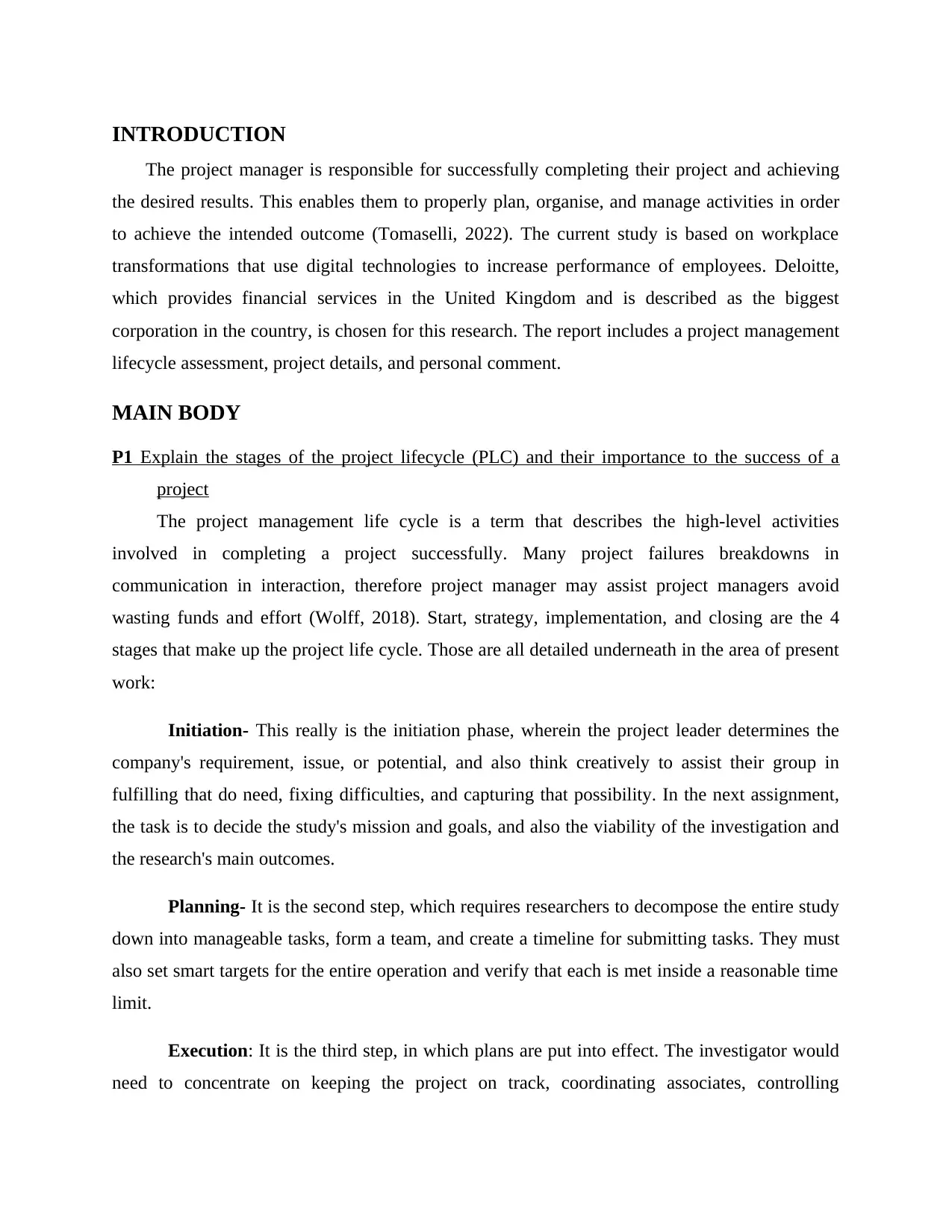
INTRODUCTION
The project manager is responsible for successfully completing their project and achieving
the desired results. This enables them to properly plan, organise, and manage activities in order
to achieve the intended outcome (Tomaselli, 2022). The current study is based on workplace
transformations that use digital technologies to increase performance of employees. Deloitte,
which provides financial services in the United Kingdom and is described as the biggest
corporation in the country, is chosen for this research. The report includes a project management
lifecycle assessment, project details, and personal comment.
MAIN BODY
P1 Explain the stages of the project lifecycle (PLC) and their importance to the success of a
project
The project management life cycle is a term that describes the high-level activities
involved in completing a project successfully. Many project failures breakdowns in
communication in interaction, therefore project manager may assist project managers avoid
wasting funds and effort (Wolff, 2018). Start, strategy, implementation, and closing are the 4
stages that make up the project life cycle. Those are all detailed underneath in the area of present
work:
Initiation- This really is the initiation phase, wherein the project leader determines the
company's requirement, issue, or potential, and also think creatively to assist their group in
fulfilling that do need, fixing difficulties, and capturing that possibility. In the next assignment,
the task is to decide the study's mission and goals, and also the viability of the investigation and
the research's main outcomes.
Planning- It is the second step, which requires researchers to decompose the entire study
down into manageable tasks, form a team, and create a timeline for submitting tasks. They must
also set smart targets for the entire operation and verify that each is met inside a reasonable time
limit.
Execution: It is the third step, in which plans are put into effect. The investigator would
need to concentrate on keeping the project on track, coordinating associates, controlling
The project manager is responsible for successfully completing their project and achieving
the desired results. This enables them to properly plan, organise, and manage activities in order
to achieve the intended outcome (Tomaselli, 2022). The current study is based on workplace
transformations that use digital technologies to increase performance of employees. Deloitte,
which provides financial services in the United Kingdom and is described as the biggest
corporation in the country, is chosen for this research. The report includes a project management
lifecycle assessment, project details, and personal comment.
MAIN BODY
P1 Explain the stages of the project lifecycle (PLC) and their importance to the success of a
project
The project management life cycle is a term that describes the high-level activities
involved in completing a project successfully. Many project failures breakdowns in
communication in interaction, therefore project manager may assist project managers avoid
wasting funds and effort (Wolff, 2018). Start, strategy, implementation, and closing are the 4
stages that make up the project life cycle. Those are all detailed underneath in the area of present
work:
Initiation- This really is the initiation phase, wherein the project leader determines the
company's requirement, issue, or potential, and also think creatively to assist their group in
fulfilling that do need, fixing difficulties, and capturing that possibility. In the next assignment,
the task is to decide the study's mission and goals, and also the viability of the investigation and
the research's main outcomes.
Planning- It is the second step, which requires researchers to decompose the entire study
down into manageable tasks, form a team, and create a timeline for submitting tasks. They must
also set smart targets for the entire operation and verify that each is met inside a reasonable time
limit.
Execution: It is the third step, in which plans are put into effect. The investigator would
need to concentrate on keeping the project on track, coordinating associates, controlling
Paraphrase This Document
Need a fresh take? Get an instant paraphrase of this document with our AI Paraphraser
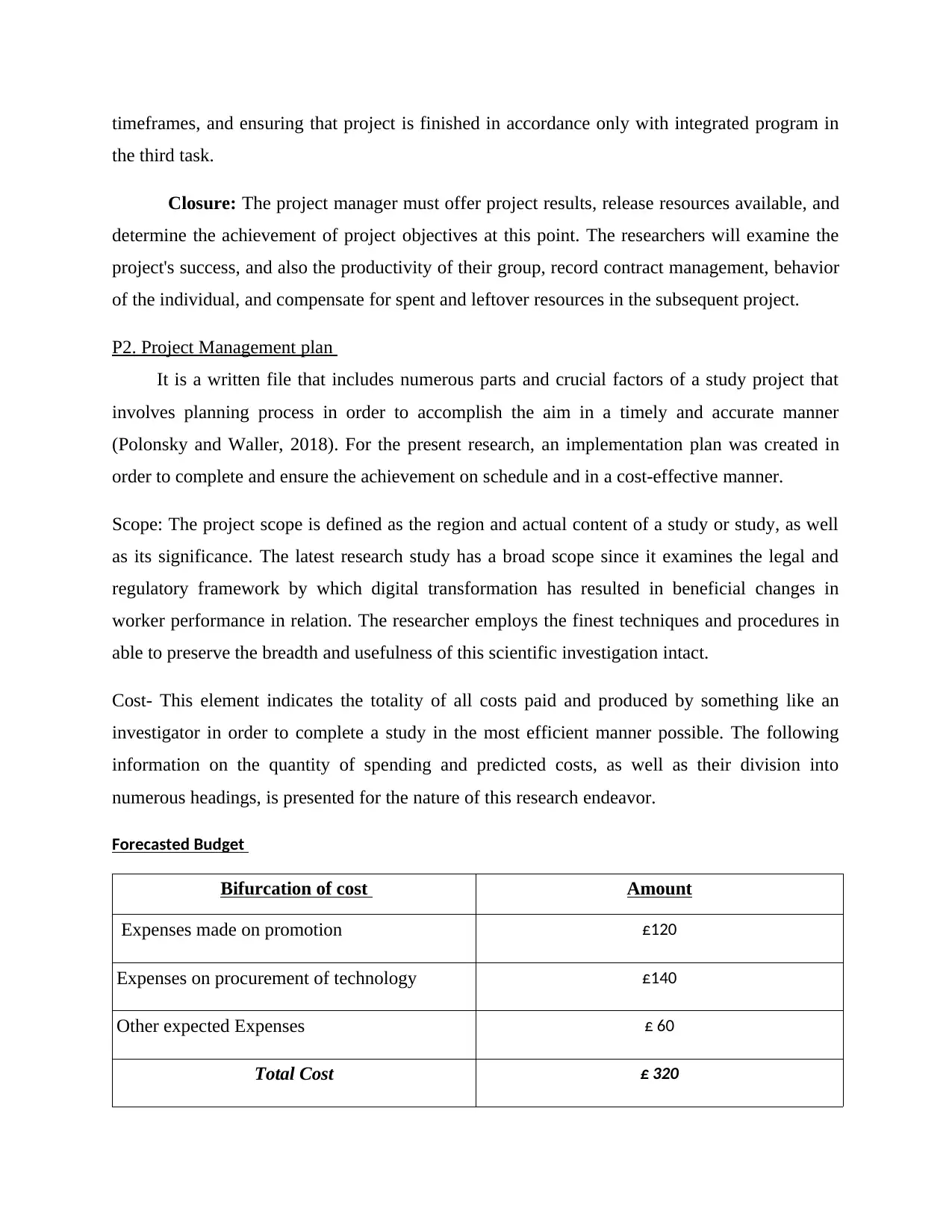
timeframes, and ensuring that project is finished in accordance only with integrated program in
the third task.
Closure: The project manager must offer project results, release resources available, and
determine the achievement of project objectives at this point. The researchers will examine the
project's success, and also the productivity of their group, record contract management, behavior
of the individual, and compensate for spent and leftover resources in the subsequent project.
P2. Project Management plan
It is a written file that includes numerous parts and crucial factors of a study project that
involves planning process in order to accomplish the aim in a timely and accurate manner
(Polonsky and Waller, 2018). For the present research, an implementation plan was created in
order to complete and ensure the achievement on schedule and in a cost-effective manner.
Scope: The project scope is defined as the region and actual content of a study or study, as well
as its significance. The latest research study has a broad scope since it examines the legal and
regulatory framework by which digital transformation has resulted in beneficial changes in
worker performance in relation. The researcher employs the finest techniques and procedures in
able to preserve the breadth and usefulness of this scientific investigation intact.
Cost- This element indicates the totality of all costs paid and produced by something like an
investigator in order to complete a study in the most efficient manner possible. The following
information on the quantity of spending and predicted costs, as well as their division into
numerous headings, is presented for the nature of this research endeavor.
Forecasted Budget
Bifurcation of cost Amount
Expenses made on promotion £120
Expenses on procurement of technology £140
Other expected Expenses £ 60
Total Cost £ 320
the third task.
Closure: The project manager must offer project results, release resources available, and
determine the achievement of project objectives at this point. The researchers will examine the
project's success, and also the productivity of their group, record contract management, behavior
of the individual, and compensate for spent and leftover resources in the subsequent project.
P2. Project Management plan
It is a written file that includes numerous parts and crucial factors of a study project that
involves planning process in order to accomplish the aim in a timely and accurate manner
(Polonsky and Waller, 2018). For the present research, an implementation plan was created in
order to complete and ensure the achievement on schedule and in a cost-effective manner.
Scope: The project scope is defined as the region and actual content of a study or study, as well
as its significance. The latest research study has a broad scope since it examines the legal and
regulatory framework by which digital transformation has resulted in beneficial changes in
worker performance in relation. The researcher employs the finest techniques and procedures in
able to preserve the breadth and usefulness of this scientific investigation intact.
Cost- This element indicates the totality of all costs paid and produced by something like an
investigator in order to complete a study in the most efficient manner possible. The following
information on the quantity of spending and predicted costs, as well as their division into
numerous headings, is presented for the nature of this research endeavor.
Forecasted Budget
Bifurcation of cost Amount
Expenses made on promotion £120
Expenses on procurement of technology £140
Other expected Expenses £ 60
Total Cost £ 320
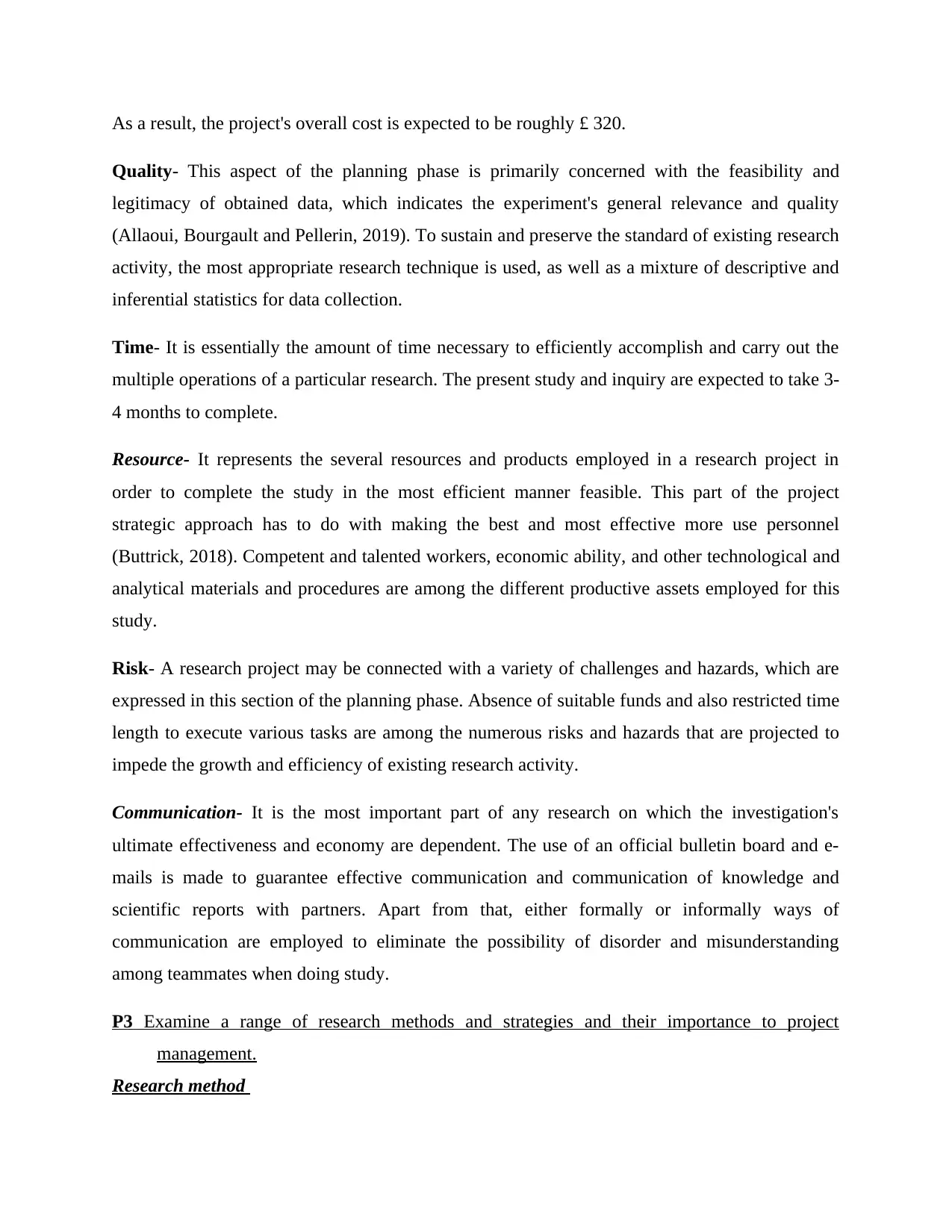
As a result, the project's overall cost is expected to be roughly £ 320.
Quality- This aspect of the planning phase is primarily concerned with the feasibility and
legitimacy of obtained data, which indicates the experiment's general relevance and quality
(Allaoui, Bourgault and Pellerin, 2019). To sustain and preserve the standard of existing research
activity, the most appropriate research technique is used, as well as a mixture of descriptive and
inferential statistics for data collection.
Time- It is essentially the amount of time necessary to efficiently accomplish and carry out the
multiple operations of a particular research. The present study and inquiry are expected to take 3-
4 months to complete.
Resource- It represents the several resources and products employed in a research project in
order to complete the study in the most efficient manner feasible. This part of the project
strategic approach has to do with making the best and most effective more use personnel
(Buttrick, 2018). Competent and talented workers, economic ability, and other technological and
analytical materials and procedures are among the different productive assets employed for this
study.
Risk- A research project may be connected with a variety of challenges and hazards, which are
expressed in this section of the planning phase. Absence of suitable funds and also restricted time
length to execute various tasks are among the numerous risks and hazards that are projected to
impede the growth and efficiency of existing research activity.
Communication- It is the most important part of any research on which the investigation's
ultimate effectiveness and economy are dependent. The use of an official bulletin board and e-
mails is made to guarantee effective communication and communication of knowledge and
scientific reports with partners. Apart from that, either formally or informally ways of
communication are employed to eliminate the possibility of disorder and misunderstanding
among teammates when doing study.
P3 Examine a range of research methods and strategies and their importance to project
management.
Research method
Quality- This aspect of the planning phase is primarily concerned with the feasibility and
legitimacy of obtained data, which indicates the experiment's general relevance and quality
(Allaoui, Bourgault and Pellerin, 2019). To sustain and preserve the standard of existing research
activity, the most appropriate research technique is used, as well as a mixture of descriptive and
inferential statistics for data collection.
Time- It is essentially the amount of time necessary to efficiently accomplish and carry out the
multiple operations of a particular research. The present study and inquiry are expected to take 3-
4 months to complete.
Resource- It represents the several resources and products employed in a research project in
order to complete the study in the most efficient manner feasible. This part of the project
strategic approach has to do with making the best and most effective more use personnel
(Buttrick, 2018). Competent and talented workers, economic ability, and other technological and
analytical materials and procedures are among the different productive assets employed for this
study.
Risk- A research project may be connected with a variety of challenges and hazards, which are
expressed in this section of the planning phase. Absence of suitable funds and also restricted time
length to execute various tasks are among the numerous risks and hazards that are projected to
impede the growth and efficiency of existing research activity.
Communication- It is the most important part of any research on which the investigation's
ultimate effectiveness and economy are dependent. The use of an official bulletin board and e-
mails is made to guarantee effective communication and communication of knowledge and
scientific reports with partners. Apart from that, either formally or informally ways of
communication are employed to eliminate the possibility of disorder and misunderstanding
among teammates when doing study.
P3 Examine a range of research methods and strategies and their importance to project
management.
Research method
⊘ This is a preview!⊘
Do you want full access?
Subscribe today to unlock all pages.

Trusted by 1+ million students worldwide

The quantitative technique of research is used out of the two major research
methodologies, namely exploratory and descriptive research techniques. The use of quantitative
approach is justified since it allows for the gathering of research results in numerical terms,
whereas qualitative data is connected with extensive as well as in collecting information, which
is more difficult and complicated (Kerzner, 2019). Thus, the use of a quantitative research
approach for this study is justified since it allows for more quality of work life as well as a more
open and efficient presenting of study results in the graphical format and descriptive statistical.
Sources of data collection
Primary and secondary sources of data are the two major sources or origins of data from
which material for a study may be acquired. Primary and secondary data sources were employed
to acquire information from current inquiry. The objective of employing primary research is to
make it easier to acquire the most up-to-date and truthful data straight from the communication,
ensuring the database's validity and dependability (Peters, Stanko and Merrett, 2019). Secondary
information, but at the other side, give an examination of verifiable events and documents in
order to corroborate main findings and can provide a good foundation for study.
Sampling
It is a data gathering strategy that provides the better use of scarce and quick completion
of a project by restricting the amount of responses (Abdullah and Foo, 2019). As a result, it is a
procedure that involves selecting a certain number of participants and persons from a huge
amount of population, resulting in a more successful study. For such empirical studies on the
relationship, random sampling was used since it eliminates the possibility of favouritism and
biased in study. For this study, a random sampling procedure was used to pick a group size of 20
respondents among Deloitte workers.
The survey technique of quantitative research is utilized to acquire information for this study,
and data is obtained via a question.
Questionnaire- A questionnaire is a structured record that is being used to obtain information in a
survey approach and involves a series of questions that are used to assess and analyse the results
of the survey in a somewhat more efficient manner.
methodologies, namely exploratory and descriptive research techniques. The use of quantitative
approach is justified since it allows for the gathering of research results in numerical terms,
whereas qualitative data is connected with extensive as well as in collecting information, which
is more difficult and complicated (Kerzner, 2019). Thus, the use of a quantitative research
approach for this study is justified since it allows for more quality of work life as well as a more
open and efficient presenting of study results in the graphical format and descriptive statistical.
Sources of data collection
Primary and secondary sources of data are the two major sources or origins of data from
which material for a study may be acquired. Primary and secondary data sources were employed
to acquire information from current inquiry. The objective of employing primary research is to
make it easier to acquire the most up-to-date and truthful data straight from the communication,
ensuring the database's validity and dependability (Peters, Stanko and Merrett, 2019). Secondary
information, but at the other side, give an examination of verifiable events and documents in
order to corroborate main findings and can provide a good foundation for study.
Sampling
It is a data gathering strategy that provides the better use of scarce and quick completion
of a project by restricting the amount of responses (Abdullah and Foo, 2019). As a result, it is a
procedure that involves selecting a certain number of participants and persons from a huge
amount of population, resulting in a more successful study. For such empirical studies on the
relationship, random sampling was used since it eliminates the possibility of favouritism and
biased in study. For this study, a random sampling procedure was used to pick a group size of 20
respondents among Deloitte workers.
The survey technique of quantitative research is utilized to acquire information for this study,
and data is obtained via a question.
Questionnaire- A questionnaire is a structured record that is being used to obtain information in a
survey approach and involves a series of questions that are used to assess and analyse the results
of the survey in a somewhat more efficient manner.
Paraphrase This Document
Need a fresh take? Get an instant paraphrase of this document with our AI Paraphraser
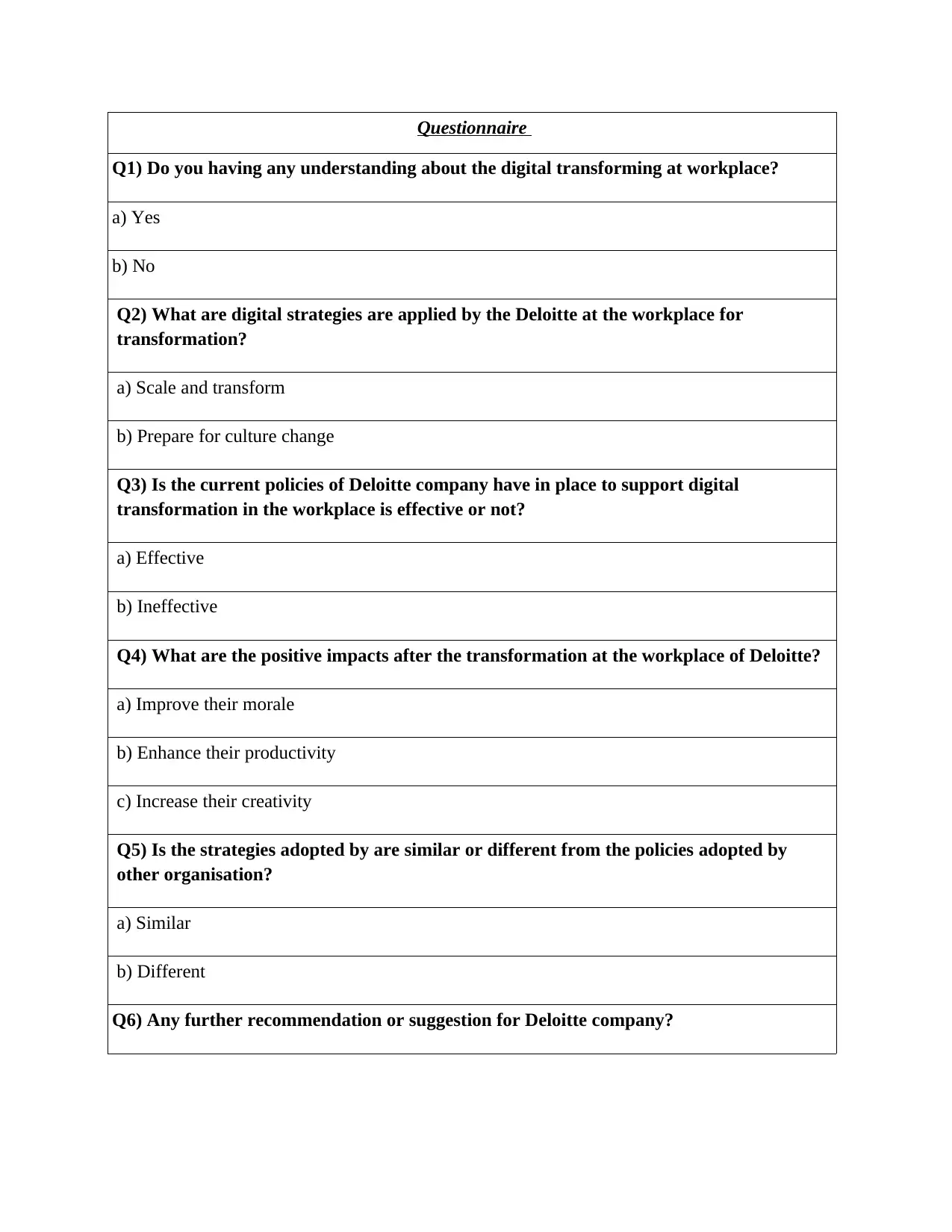
Questionnaire
Q1) Do you having any understanding about the digital transforming at workplace?
a) Yes
b) No
Q2) What are digital strategies are applied by the Deloitte at the workplace for
transformation?
a) Scale and transform
b) Prepare for culture change
Q3) Is the current policies of Deloitte company have in place to support digital
transformation in the workplace is effective or not?
a) Effective
b) Ineffective
Q4) What are the positive impacts after the transformation at the workplace of Deloitte?
a) Improve their morale
b) Enhance their productivity
c) Increase their creativity
Q5) Is the strategies adopted by are similar or different from the policies adopted by
other organisation?
a) Similar
b) Different
Q6) Any further recommendation or suggestion for Deloitte company?
Q1) Do you having any understanding about the digital transforming at workplace?
a) Yes
b) No
Q2) What are digital strategies are applied by the Deloitte at the workplace for
transformation?
a) Scale and transform
b) Prepare for culture change
Q3) Is the current policies of Deloitte company have in place to support digital
transformation in the workplace is effective or not?
a) Effective
b) Ineffective
Q4) What are the positive impacts after the transformation at the workplace of Deloitte?
a) Improve their morale
b) Enhance their productivity
c) Increase their creativity
Q5) Is the strategies adopted by are similar or different from the policies adopted by
other organisation?
a) Similar
b) Different
Q6) Any further recommendation or suggestion for Deloitte company?
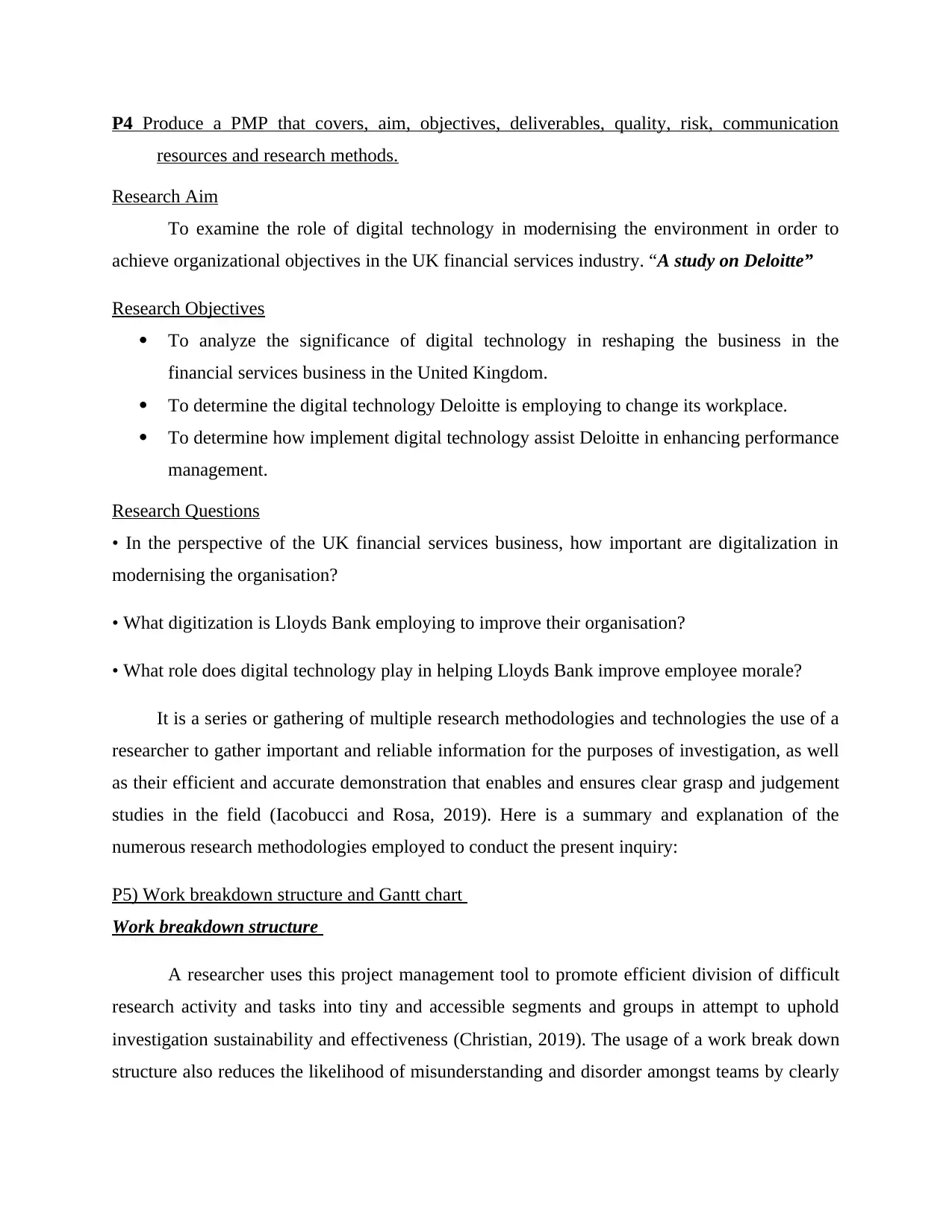
P4 Produce a PMP that covers, aim, objectives, deliverables, quality, risk, communication
resources and research methods.
Research Aim
To examine the role of digital technology in modernising the environment in order to
achieve organizational objectives in the UK financial services industry. “A study on Deloitte”
Research Objectives
To analyze the significance of digital technology in reshaping the business in the
financial services business in the United Kingdom.
To determine the digital technology Deloitte is employing to change its workplace.
To determine how implement digital technology assist Deloitte in enhancing performance
management.
Research Questions
• In the perspective of the UK financial services business, how important are digitalization in
modernising the organisation?
• What digitization is Lloyds Bank employing to improve their organisation?
• What role does digital technology play in helping Lloyds Bank improve employee morale?
It is a series or gathering of multiple research methodologies and technologies the use of a
researcher to gather important and reliable information for the purposes of investigation, as well
as their efficient and accurate demonstration that enables and ensures clear grasp and judgement
studies in the field (Iacobucci and Rosa, 2019). Here is a summary and explanation of the
numerous research methodologies employed to conduct the present inquiry:
P5) Work breakdown structure and Gantt chart
Work breakdown structure
A researcher uses this project management tool to promote efficient division of difficult
research activity and tasks into tiny and accessible segments and groups in attempt to uphold
investigation sustainability and effectiveness (Christian, 2019). The usage of a work break down
structure also reduces the likelihood of misunderstanding and disorder amongst teams by clearly
resources and research methods.
Research Aim
To examine the role of digital technology in modernising the environment in order to
achieve organizational objectives in the UK financial services industry. “A study on Deloitte”
Research Objectives
To analyze the significance of digital technology in reshaping the business in the
financial services business in the United Kingdom.
To determine the digital technology Deloitte is employing to change its workplace.
To determine how implement digital technology assist Deloitte in enhancing performance
management.
Research Questions
• In the perspective of the UK financial services business, how important are digitalization in
modernising the organisation?
• What digitization is Lloyds Bank employing to improve their organisation?
• What role does digital technology play in helping Lloyds Bank improve employee morale?
It is a series or gathering of multiple research methodologies and technologies the use of a
researcher to gather important and reliable information for the purposes of investigation, as well
as their efficient and accurate demonstration that enables and ensures clear grasp and judgement
studies in the field (Iacobucci and Rosa, 2019). Here is a summary and explanation of the
numerous research methodologies employed to conduct the present inquiry:
P5) Work breakdown structure and Gantt chart
Work breakdown structure
A researcher uses this project management tool to promote efficient division of difficult
research activity and tasks into tiny and accessible segments and groups in attempt to uphold
investigation sustainability and effectiveness (Christian, 2019). The usage of a work break down
structure also reduces the likelihood of misunderstanding and disorder amongst teams by clearly
⊘ This is a preview!⊘
Do you want full access?
Subscribe today to unlock all pages.

Trusted by 1+ million students worldwide
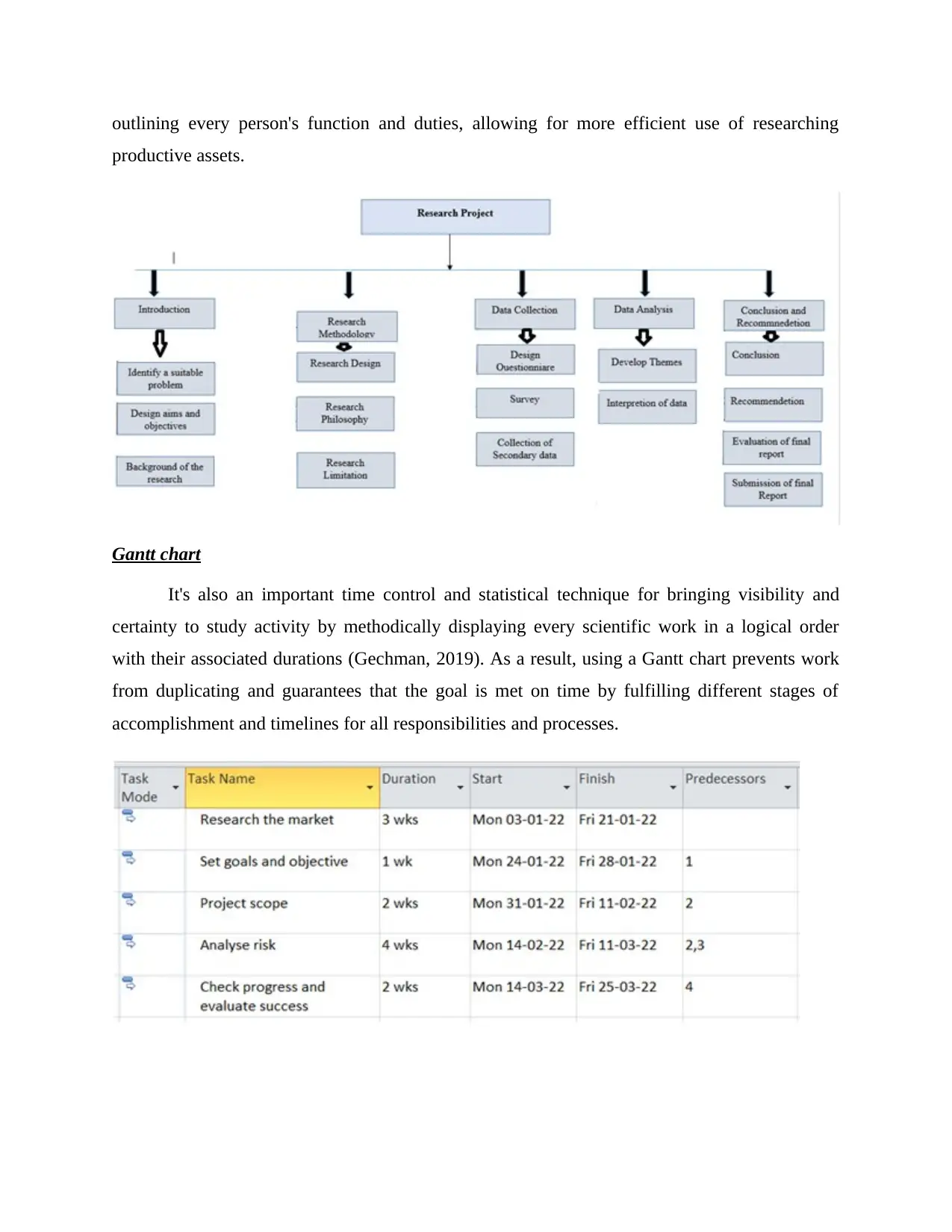
outlining every person's function and duties, allowing for more efficient use of researching
productive assets.
Gantt chart
It's also an important time control and statistical technique for bringing visibility and
certainty to study activity by methodically displaying every scientific work in a logical order
with their associated durations (Gechman, 2019). As a result, using a Gantt chart prevents work
from duplicating and guarantees that the goal is met on time by fulfilling different stages of
accomplishment and timelines for all responsibilities and processes.
productive assets.
Gantt chart
It's also an important time control and statistical technique for bringing visibility and
certainty to study activity by methodically displaying every scientific work in a logical order
with their associated durations (Gechman, 2019). As a result, using a Gantt chart prevents work
from duplicating and guarantees that the goal is met on time by fulfilling different stages of
accomplishment and timelines for all responsibilities and processes.
Paraphrase This Document
Need a fresh take? Get an instant paraphrase of this document with our AI Paraphraser
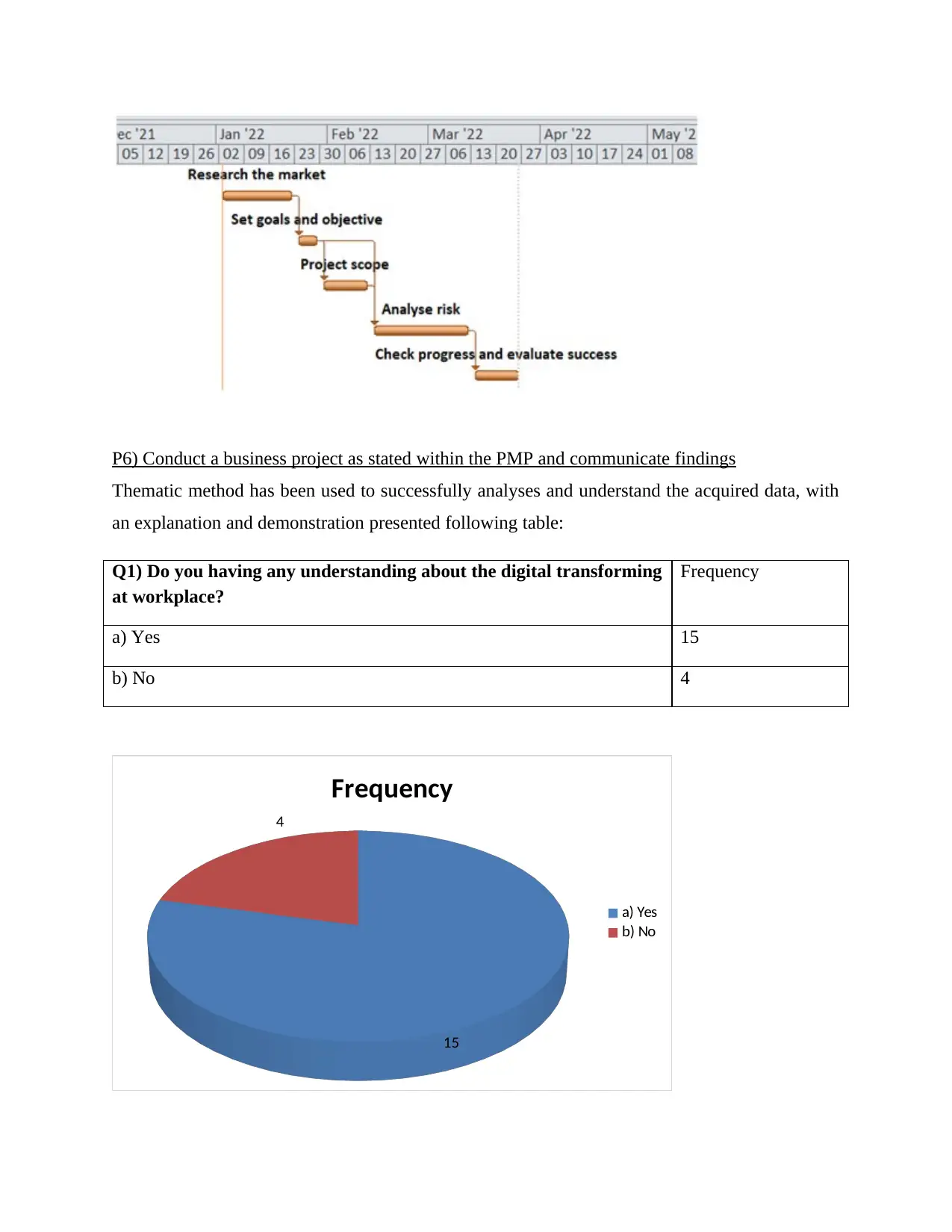
P6) Conduct a business project as stated within the PMP and communicate findings
Thematic method has been used to successfully analyses and understand the acquired data, with
an explanation and demonstration presented following table:
Q1) Do you having any understanding about the digital transforming
at workplace?
Frequency
a) Yes 15
b) No 4
15
4
Frequency
a) Yes
b) No
Thematic method has been used to successfully analyses and understand the acquired data, with
an explanation and demonstration presented following table:
Q1) Do you having any understanding about the digital transforming
at workplace?
Frequency
a) Yes 15
b) No 4
15
4
Frequency
a) Yes
b) No
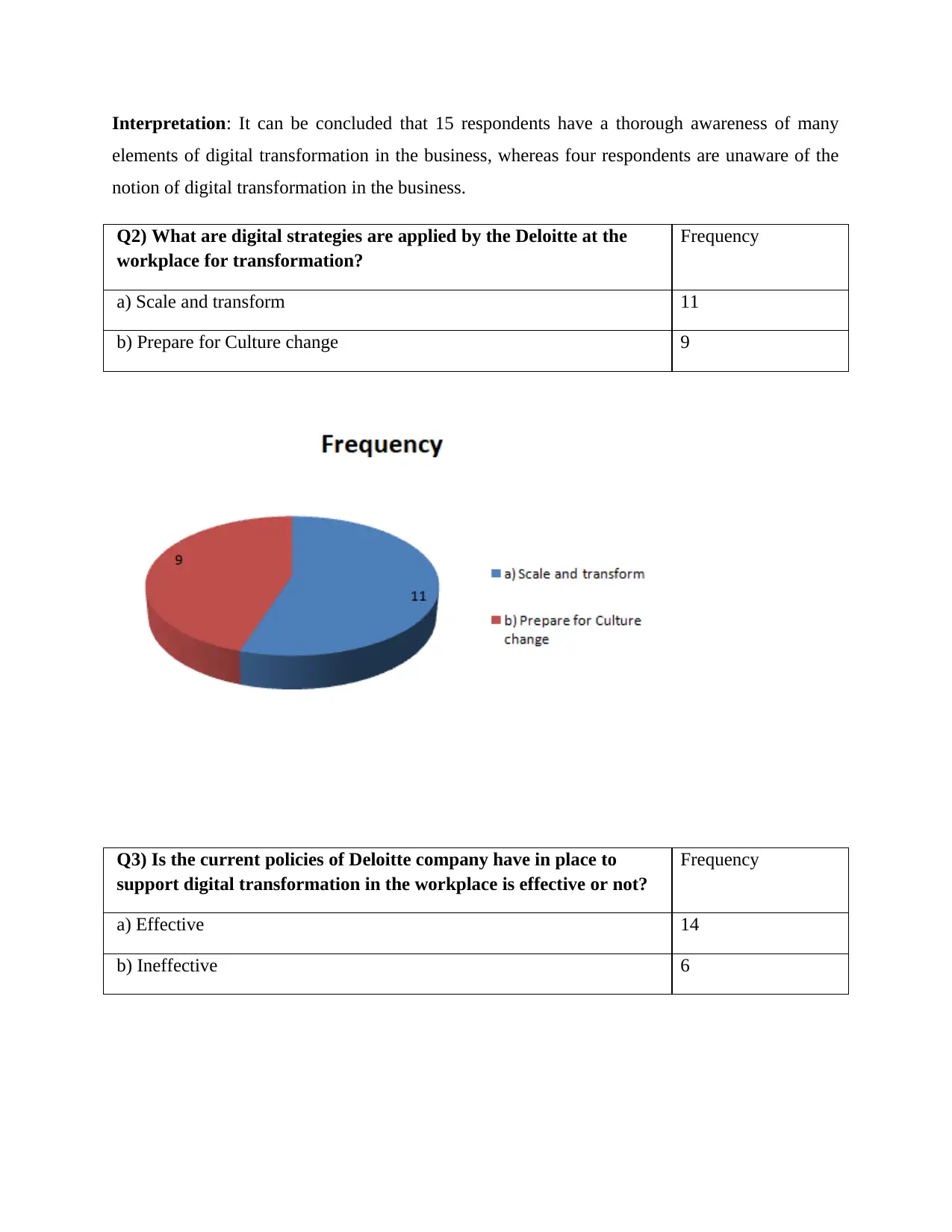
Interpretation: It can be concluded that 15 respondents have a thorough awareness of many
elements of digital transformation in the business, whereas four respondents are unaware of the
notion of digital transformation in the business.
Q2) What are digital strategies are applied by the Deloitte at the
workplace for transformation?
Frequency
a) Scale and transform 11
b) Prepare for Culture change 9
Q3) Is the current policies of Deloitte company have in place to
support digital transformation in the workplace is effective or not?
Frequency
a) Effective 14
b) Ineffective 6
elements of digital transformation in the business, whereas four respondents are unaware of the
notion of digital transformation in the business.
Q2) What are digital strategies are applied by the Deloitte at the
workplace for transformation?
Frequency
a) Scale and transform 11
b) Prepare for Culture change 9
Q3) Is the current policies of Deloitte company have in place to
support digital transformation in the workplace is effective or not?
Frequency
a) Effective 14
b) Ineffective 6
⊘ This is a preview!⊘
Do you want full access?
Subscribe today to unlock all pages.

Trusted by 1+ million students worldwide
1 out of 17
Related Documents
Your All-in-One AI-Powered Toolkit for Academic Success.
+13062052269
info@desklib.com
Available 24*7 on WhatsApp / Email
![[object Object]](/_next/static/media/star-bottom.7253800d.svg)
Unlock your academic potential
Copyright © 2020–2025 A2Z Services. All Rights Reserved. Developed and managed by ZUCOL.



